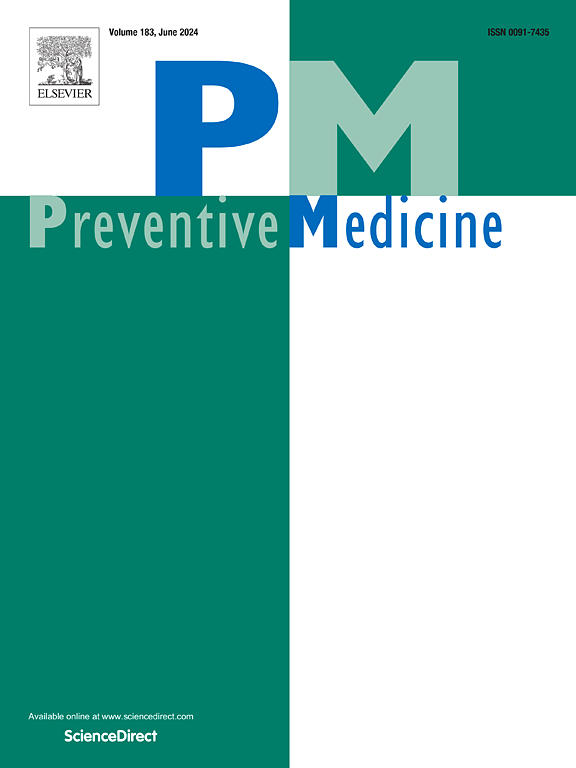在丹麦,到全科医生的路途距离和妇女参与宫颈癌筛查——一项基于人群的队列研究,2017
IF 3.2
2区 医学
Q1 MEDICINE, GENERAL & INTERNAL
引用次数: 0
摘要
目的以往的研究发现宫颈癌筛查项目的利用存在差异。与筛查地点的地理距离可能会影响妇女的参与。本研究的目的是调查从住所到全科医生的旅行距离之间的关系,并邀请妇女参加国家宫颈癌筛查计划。方法数据来自丹麦国家登记册,包括2017年受邀参加筛查项目的所有女性(n = 341,708)。从住所到全科医生的旅行距离是根据地理编码地址和道路网络计算的。采用多水平逻辑回归计算参与的比值比(ORs),置信区间为95%。结果在271,959名信息完整的女性中,出行距离为1.0-4.9 km的女性的筛查参与率从67.7%下降到≥15.0 km的女性的61.1%。经种族、教育程度和年龄调整后,距离全科医生≥15.0公里的妇女与距离1.0-4.9公里的妇女相比,参与治疗的几率低22% (OR = 0.78, 95% CI[0.75;0.81])。距离全科医生1.0公里的妇女参与的几率低10% (OR = 0.90, 95% CI[0.88;0.93])。敏感性分析表明,当距离≥5 km时,暴露-反应关系,表明距离大于5 km时,参与的几率越低。结论到全科医生的距离与参与筛查有关。今后的举措应促进平等获得预防性保健服务,重点是与全科医生相距很远的妇女以及与全科医生住得很近的妇女。本文章由计算机程序翻译,如有差异,请以英文原文为准。
Travel distance to the general practitioner and women's participation in cervical cancer screening in Denmark – A population-based cohort study, 2017
Objectives
Previous studies found disparities in utilization of cervical cancer screening programs. Geographical distance to the screening location may affect women's participation. The aim of this study was to investigate the association between travel distance from residence to general practitioner, and invited women's participation in a national screening program for cervical cancer.
Methods
Data were obtained from Danish national registers including all women invited to the screening program in 2017 (n = 341,708). Travel distance from residence to the general practitioner was calculated based on geocoded addresses and the road network. Multilevel logistic regression was used to calculate odds ratios (ORs) of participation with 95 % confidence intervals (CI).
Results
Based on 271,959 women with complete information, screening participation decreased from 67.7 % among women with a travel distance of 1.0–4.9 km to 61.1 % among women with ≥15.0 km. Adjusted for ethnicity, education, and age, women with ≥15.0 km to the general practitioner had 22 % lower odds of participation compared to those living 1.0–4.9 km away (OR = 0.78, 95 %CI [0.75;0.81]). Women with <1.0 km to the general practitioner had 10 % lower odds of participation (OR = 0.90, 95 %CI [0.88;0.93]). Sensitivity analysis indicated an exposure-response relationship when distance was ≥5 km, implying lower odds of participation with increasing distance above 5 km.
Conclusion
Travel distance to the general practitioner was associated with participation in screening. Future initiatives should promote equal access to preventive health services focusing on women having a long travel distance to their general practitioner, as well as those living very close to their general practitioner.
求助全文
通过发布文献求助,成功后即可免费获取论文全文。
去求助
来源期刊

Preventive medicine
医学-公共卫生、环境卫生与职业卫生
CiteScore
7.70
自引率
3.90%
发文量
0
审稿时长
42 days
期刊介绍:
Founded in 1972 by Ernst Wynder, Preventive Medicine is an international scholarly journal that provides prompt publication of original articles on the science and practice of disease prevention, health promotion, and public health policymaking. Preventive Medicine aims to reward innovation. It will favor insightful observational studies, thoughtful explorations of health data, unsuspected new angles for existing hypotheses, robust randomized controlled trials, and impartial systematic reviews. Preventive Medicine''s ultimate goal is to publish research that will have an impact on the work of practitioners of disease prevention and health promotion, as well as of related disciplines.
 求助内容:
求助内容: 应助结果提醒方式:
应助结果提醒方式:


